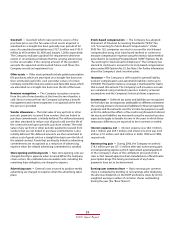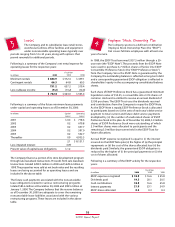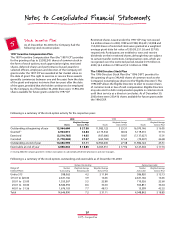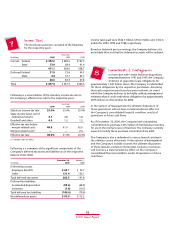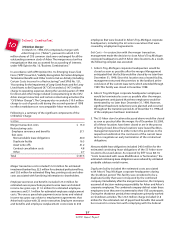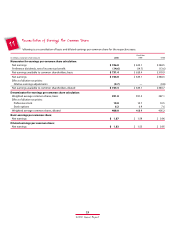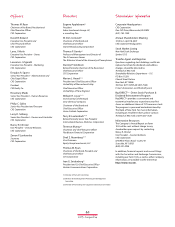CVS 2000 Annual Report Download - page 36
Download and view the complete annual report
Please find page 36 of the 2000 CVS annual report below. You can navigate through the pages in the report by either clicking on the pages listed below, or by using the keyword search tool below to find specific information within the annual report.
Business Segments
The Company currently operates four business
segments: Retail Pharmacy, Pharmacy Benefit
Management (“PBM”), Specialty Pharmacy and
Internet Pharmacy. The Company’s business segments are
operating units that offer different products and services, and
require distinct technology and marketing strategies.
The Retail Pharmacy segment, which includes 4,087 retail
drugstores located in 24 states and the District of Columbia,
operates under the CVS/pharmacy name.The Retail Pharmacy
segment is the Company’s only reportable segment.
The PBM segment provides a full range of prescription benefit
management services to managed care providers and other
organizations.These services include plan design and adminis-
tration, formulary management, mail order pharmacy services,
claims processing and generic substitution.The PBM segment
operates under the PharmaCare Management Services name.
The Specialty Pharmacy segment, which includes mail order
facilities and 46 retail pharmacies located in 17 states and the
District of Columbia, operates under the CVS ProCare name. The
Specialty Pharmacy segment focuses on supporting individuals
that require complex and expensive drug therapies.
The Internet Pharmacy segment, which includes a mail order
facility and a complete online retail pharmacy, operates under
the CVS.com name.
The accounting policies of the segments are substantially the
same as those described in Note 1. The Company evaluates
segment performance based on operating profit before the
effect of nonrecurring charges and gains and intersegment profits.
Following is a reconciliation of the significant components of the
Retail Pharmacy segment’s net sales for the respective years.
Notes to Consolidated Financial Statements
34
CVS Corporation
9
2000 1999 1998
Pharmacy 62.7% 58.7% 57.6%
Front store 37.3 41.3 42.4
Total net sales 100.0% 100.0% 100.0%
Following is a reconciliation of the Company’s business segments to the consolidated financial statements:
Retail Pharmacy All Other Intersegment Other Consolidated
In millions Segment Segments Eliminations(1) Adjustments(2) Totals
2000:
Net sales $ 19,372.4 $ 975.8 $ (260.7) $ — $ 20,087.5
Operating profit 1,290.7 12.8 — 19.2 1,322.7
Depreciation and amortization 285.4 11.2 — — 296.6
Total assets 7,498.8 478.7 (28.0) — 7,949.5
Capital expenditures 679.2 16.1 — — 695.3
1999:
Net sales $ 17,625.7 $ 888.4 $ (415.8) $ — $ 18,098.3
Operating profit 1,120.4 15.1 — — 1,135.5
Depreciation and amortization 274.6 3.3 — — 277.9
Total assets 7,146.1 173.4 (44.1) — 7,275.4
Capital expenditures 706.3 16.4 — — 722.7
1998:
Net sales $ 15,081.1 $ 488.4 $ (295.9) $ — $ 15,273.6
Operating profit 927.8 12.7 — (188.6) 751.9
Depreciation and amortization 248.6 1.1 — — 249.7
Total assets 6,602.1 119.6 (35.5) — 6,686.2
Capital expenditures 498.0 4.3 — — 502.3
(1) Intersegment eliminations relate to intersegment sales and accounts receivables that occur when a Pharmacy Benefit Management segment customer uses a Retail Pharmacy segment
store to purchase covered merchandise. When this occurs, both segments record the sale on a stand-alone basis.
(2) In 1998, other adjustments relate to merger, restructuring and other nonrecurring charges associated with the Revco and Arbor mergers. In 2000, other adjustments relate to the
nonrecurring gain representing a partial payment of the settlement proceeds from a class action lawsuit against certain manufacturers of brand name prescription drugs.The charges
and gain are not considered when management assesses the stand-alone performance of the Company’s business segments.





